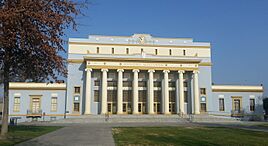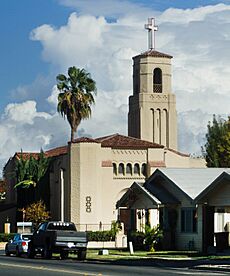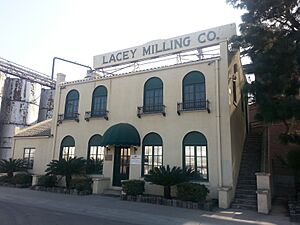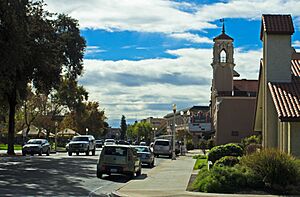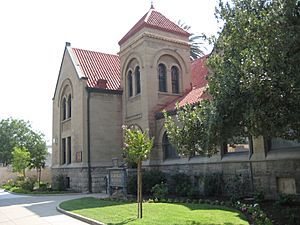Hanford, California facts for kids
Quick facts for kids
Hanford, California
|
||
|---|---|---|
| City of Hanford | ||
|
The Hanford Auditorium
Kings County Courthouse
Veteran Memorial Hall
|
||
|
||
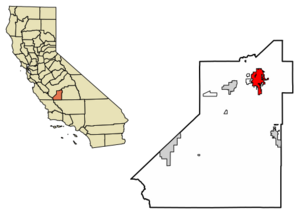
Location in Kings County and the state of California
|
||
| Country | ||
| State | ||
| County | Kings | |
| Incorporated | August 12, 1891 | |
| Area | ||
| • Total | 17.40 sq mi (45.07 km2) | |
| • Land | 17.40 sq mi (45.07 km2) | |
| • Water | 0.00 sq mi (0.00 km2) 0% | |
| Elevation | 249 ft (76 m) | |
| Population
(2020)
|
||
| • Total | 57,990 | |
| • Density | 3,332.8/sq mi (1,286.67/km2) | |
| Time zone | UTC−8 (Pacific) | |
| • Summer (DST) | UTC−7 (PDT) | |
| ZIP codes |
93230, 93232
|
|
| Area code(s) | 559 | |
| FIPS code | 06-31960 | |
| GNIS feature ID | 2410696 | |
Hanford is the biggest city and the main town (called the county seat) in Kings County, California. It's located in the San Joaquin Valley, which is part of California's large Central Valley. In 2010, about 53,967 people lived there.
Contents
History of Hanford, California
Today's Hanford was once north of Tulare Lake, which was the largest freshwater lake west of the Mississippi River. For thousands of years before Europeans arrived, the Tachi Yokuts Indians lived in this area. They settled near water sources like creeks, springs, and wet areas called sloughs.
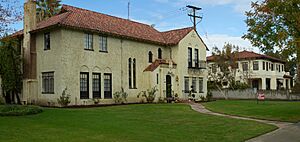
After California became part of the United States following the Mexican–American War, American settlers and immigrants moved to this area to farm. This farmland was known as "Mussel Slough." The oldest known grave in the area is from 1860. As more people settled, rivers feeding Tulare Lake were used for farming. This caused the lake to shrink and eventually disappear over time.
In the mid-to-late 1870s, the Southern Pacific Railroad planned to build train tracks here. This brought more workers and people to the area. Hanford was named after James Madison Hanford, who was an important person in the railroad company. The first map showing the settlement as "Hanford" was made in 1876. Train tracks were laid through a sheep camp in 1877. The town quickly grew from a sheep camp into a busy place. Many of the workers who built the tracks were Chinese immigrants.
By 1877, Hanford started appearing in state newspapers. In 1878, Hanford even started its own newspaper called "The Public Good." In May 1878, people in Hanford protested against the Southern Pacific Railroad buying land where settlers already lived.
In May 1880, a fight over land between settlers and the Southern Pacific Railroad turned into a gun battle. This happened about 5.6 miles (9 km) northwest of Hanford and seven men died. This event is known as the Mussel Slough Tragedy. The next month, the first census counted 269 people in the town. Forty-four of them were Chinese immigrants living in an area now called China Alley.
A post office was set up in 1887. Major fires often destroyed parts of the town's business area. Because of this, the town decided to become an incorporated city in 1891 to get better fire protection. Yamon LeBaron was Hanford's first mayor.
In 1891, H.G. Lacey built an electrical plant, bringing the first electric lights to Hanford. His company, Lacey Milling Company, operated for 136 years before closing in 2023.
The first public high school, Hanford Union High School, opened in 1892. It started with one teacher and about fourteen students. When Kings County was created in 1893, Hanford became its main town, or county seat.
A second railroad line was built through Hanford in 1897. Today, this is the main north-south line for the BNSF Railway. The original east-west Southern Pacific Railroad line is now used by the San Joaquin Valley Railroad.
In the 1930s, the famous pilot Amelia Earhart lived in Hanford. She taught flying lessons at Fresno Chandler Airport. She became friends with a student named Mary Packwood. Before Amelia Earhart disappeared in 1937, she gave Mary a dress she designed and some luggage. These items are now on display at Hanford's Carnegie Museum.
Geography and Climate
Hanford is in the south-central part of California's San Joaquin Valley. It's about 28 miles (45 km) south of Fresno and 18 miles (29 km) west of Visalia. The city is 249 feet (76 m) above sea level and has flat land. Hanford covers about 16.6 square miles (43 km2), all of which is land. The only natural watercourse (a stream or river) is Mussel Slough, with parts still existing on the city's western edge. The Kings River is about 6.5 miles (10.5 km) north of Hanford. An irrigation canal called the People's Ditch, built in the 1870s, runs through Hanford.
Hanford's Climate
Hanford has a cold-semi arid climate. This means it has hot, dry summers and cool winters. Winters often have thick tule fog. The rainy season is from November to March. The average rainfall is about 8.97 inches (22.8 cm) per year.
| Climate data for Hanford Municipal Airport, California (1991–2020 normals, extremes 1899–present) | |||||||||||||
|---|---|---|---|---|---|---|---|---|---|---|---|---|---|
| Month | Jan | Feb | Mar | Apr | May | Jun | Jul | Aug | Sep | Oct | Nov | Dec | Year |
| Record high °F (°C) | 95 (35) |
94 (34) |
95 (35) |
100 (38) |
107 (42) |
114 (46) |
116 (47) |
115 (46) |
114 (46) |
105 (41) |
94 (34) |
80 (27) |
116 (47) |
| Mean maximum °F (°C) | 66.8 (19.3) |
72.5 (22.5) |
81.5 (27.5) |
90.6 (32.6) |
98.3 (36.8) |
104.1 (40.1) |
105.6 (40.9) |
105.3 (40.7) |
101.6 (38.7) |
93.2 (34.0) |
79.1 (26.2) |
66.8 (19.3) |
107.4 (41.9) |
| Mean daily maximum °F (°C) | 56.6 (13.7) |
63.0 (17.2) |
69.8 (21.0) |
76.3 (24.6) |
84.6 (29.2) |
92.5 (33.6) |
98.2 (36.8) |
97.4 (36.3) |
92.1 (33.4) |
80.7 (27.1) |
66.6 (19.2) |
56.7 (13.7) |
77.9 (25.5) |
| Daily mean °F (°C) | 46.8 (8.2) |
50.9 (10.5) |
56.7 (13.7) |
61.8 (16.6) |
69.2 (20.7) |
76.0 (24.4) |
81.1 (27.3) |
79.9 (26.6) |
74.7 (23.7) |
64.6 (18.1) |
53.2 (11.8) |
46.0 (7.8) |
63.4 (17.5) |
| Mean daily minimum °F (°C) | 37.0 (2.8) |
38.9 (3.8) |
43.5 (6.4) |
47.2 (8.4) |
53.8 (12.1) |
59.5 (15.3) |
64.0 (17.8) |
62.4 (16.9) |
57.4 (14.1) |
48.5 (9.2) |
39.8 (4.3) |
35.3 (1.8) |
48.9 (9.4) |
| Mean minimum °F (°C) | 27.6 (−2.4) |
30.4 (−0.9) |
34.5 (1.4) |
37.5 (3.1) |
45.5 (7.5) |
50.5 (10.3) |
57.3 (14.1) |
55.9 (13.3) |
49.0 (9.4) |
39.2 (4.0) |
30.2 (−1.0) |
26.2 (−3.2) |
24.8 (−4.0) |
| Record low °F (°C) | 14 (−10) |
18 (−8) |
23 (−5) |
25 (−4) |
30 (−1) |
36 (2) |
44 (7) |
40 (4) |
35 (2) |
28 (−2) |
18 (−8) |
15 (−9) |
14 (−10) |
| Average precipitation inches (mm) | 1.56 (40) |
1.44 (37) |
1.49 (38) |
0.72 (18) |
0.35 (8.9) |
0.07 (1.8) |
0.02 (0.51) |
0.00 (0.00) |
0.04 (1.0) |
0.46 (12) |
0.62 (16) |
1.36 (35) |
8.13 (208.21) |
| Average precipitation days (≥ 0.01 in) | 8.3 | 8.1 | 6.8 | 4.5 | 2.5 | 0.5 | 0.2 | 0.1 | 0.5 | 2.8 | 6.7 | 8.7 | 49.7 |
| Source 1: NOAA | |||||||||||||
| Source 2: National Weather Service | |||||||||||||
Population and People
| Historical population | |||
|---|---|---|---|
| Census | Pop. | %± | |
| 1880 | 269 | — | |
| 1890 | 942 | 250.2% | |
| 1900 | 2,929 | 210.9% | |
| 1910 | 4,829 | 64.9% | |
| 1920 | 5,888 | 21.9% | |
| 1930 | 7,028 | 19.4% | |
| 1940 | 8,234 | 17.2% | |
| 1950 | 10,028 | 21.8% | |
| 1960 | 10,133 | 1.0% | |
| 1970 | 15,179 | 49.8% | |
| 1980 | 20,958 | 38.1% | |
| 1990 | 30,897 | 47.4% | |
| 2000 | 41,686 | 34.9% | |
| 2010 | 53,967 | 29.5% | |
| 2020 | 57,990 | 7.5% | |
| 2022 (est.) | 58,470 | 8.3% | |
| U.S. Decennial Census | |||
Hanford's Population in 2010
The 2010 United States Census showed that Hanford had 53,967 people. Most residents (62.5%) were White. About 4.9% were African American, 1.3% Native American, and 4.3% Asian. A large part of the population, 47.1%, identified as Hispanic or Latino.
About 98.3% of the people lived in regular homes. There were 17,492 households. Many households (46%) had children under 18. The average household had about 3 people.
The population was quite young, with 31% of people under 18. The median age was 30.9 years. This means half the people were younger than 30.9 and half were older.
Hanford's Population in 2000
In the year 2000, Hanford had 41,686 people. About 64.1% were White, and 38.7% were Hispanic or Latino.
About 13.2% of Hanford's residents were born in other countries. Also, 28.3% of people spoke a language other than English at home.
The population was spread out, with 31.6% of people under 18. The median age was 31 years.
Hanford's Economy
Hanford is an important trading center for the farms around it. Many people in the Hanford area work in services, government, and farming. Some also work in manufacturing.
In the past, Hanford had more heavy industries. An oil refinery operated here until 1987. A tire factory, built in 1962, closed in 2001. However, in 2017, a company called Faraday Future announced plans to make electric cars at the old tire factory. They hope to create many jobs and build up to 10,000 cars a year.
Some of the biggest employers in Hanford include the Kings County government, Adventist Health, and the Hanford Elementary School District. Del Monte Foods has a tomato cannery that hires many seasonal workers. Marquez Brothers International makes Hispanic cheese and dairy products. Many Hanford residents also work at NAS Lemoore, a large U.S. Navy base nearby, or for the California Department of Corrections and Rehabilitation at state prisons in Kings County.
Arts and Culture in Hanford
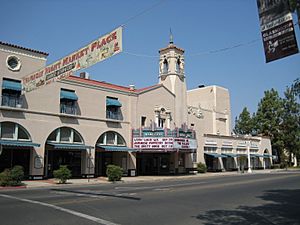
The Kings Art Center opened in 1989. It's the main place for visual arts in Kings County. It has art shows and offers art classes for both kids and adults.
The Kings District Fair is a traditional county fair held every year in mid-June. The Renaissance of Kings Cultural Arts Faire happens in early October at Courthouse Square. This event usually brings about 15,000 people to the city center.
The Kings Symphony Orchestra started in 1963. Musicians from all over the San Joaquin Valley play in it. They usually perform four times a year.
In 1903, Andrew Carnegie, a famous businessman, gave money to build the Hanford Carnegie Library. It opened in 1905. A new library was built in 1968. The old library was later fixed up and reopened as the Hanford Carnegie Museum in 1975.
Chinese immigrants came to Hanford in the late 1800s and created a busy Chinatown around China Alley. The historic Taoist Temple, built in 1893, is located there. A Moon Festival is held in China Alley every October. There are plans to make China Alley even better for visitors.
Sports and Recreation
Hanford hosts the Hanford Criterium bicycle races. These races happen on a Sunday in late March or early April. The race course is a 0.9-mile (1.4 km) loop through downtown streets.
Dirt track auto racing takes place at the Kings Speedway from March to October. The track is a 3/8-mile (0.6 km) oval made of clay, located at the Kings Fairgrounds.
Education in Hanford
Hanford has 15 elementary schools, three junior high schools, and four high schools. There are about 8,464 students in kindergarten through 8th grade and 3,522 high school students.
The Hanford Elementary School District teaches most students from kindergarten to eighth grade. The Pioneer Union Elementary School District and Kings River-Hardwick School District serve parts of northern Hanford. The Hanford Joint Union High School District runs the public high schools: Hanford Union High School, Hanford West High School, Sierra Pacific High School, and Earl F. Johnson High School.
The College of the Sequoias has an education center in Hanford. Brandman University also has a campus in Hanford for adult students.
Transportation Options
Kings Area Regional Transit (KART) provides bus services throughout Kings County and to Fresno.
Rail Travel
Amtrak offers passenger train service from Hanford station to the San Francisco Bay Area and Sacramento. You can also travel to Southern California by combining train and bus services. Freight trains also use the lines run by the BNSF Railway and the San Joaquin Valley Railroad.
There are plans for a California High-Speed Rail station in Hanford. However, this station is "optional" and would need local funding to be built.
Air Travel
The Hanford Municipal Airport is used for general aviation (smaller planes). It has a paved runway that is 5,175 feet (1,577 m) long.
City Utilities
Water System
Hanford's water comes from 14 deep wells. These wells range from 600 feet (183 m) to 1,700 feet (518 m) deep. The city has 203 miles (327 km) of water pipes. In the past, the water had natural arsenic, but since 2009, it has been below the safe federal standard. Hanford's drinking water also naturally contains hydrogen sulfide, which used to make it smell like "rotten eggs." In 2015, the city started adding chlorine to the water to remove this smell.
Sanitation System
The city's sewer system has 212 miles (341 km) of pipes and 22 pump stations. The wastewater treatment plant cleans 5 million US gallons (19 million liters) of sewage every day. The cleaned water is then used to water crops that are not for eating.
Sister City
Notable People from Hanford
Many interesting people have connections to Hanford:
- Leslie Bassett was a composer who won a Pulitzer Prize.
- Ken Caminiti was a Major League Baseball player and won the National League MVP award.
- Tyson Chandler is a basketball player in the National Basketball Association.
- Amelia Earhart, the famous pilot, lived here for a time.
- Jessica Gao, a television writer and producer, was born in Hanford.
- Tyler Henry, a self-proclaimed psychic medium.
- Steve Perry is a rock singer from the band Journey.
- Slim Pickens, a cowboy and actor, grew up in Hanford.
- J. G. Quintel, the creator of Regular Show.
- James Rainwater, a physicist who won the Nobel Prize in Physics in 1975.
- Matt Shively, an actor known for True Jackson, VP.
- Jan-Michael Vincent, an actor, moved to Hanford as a teenager.
- Cornelius Warmerdam, a pole vault world record holder, grew up here.
See also
 In Spanish: Hanford (California) para niños
In Spanish: Hanford (California) para niños


